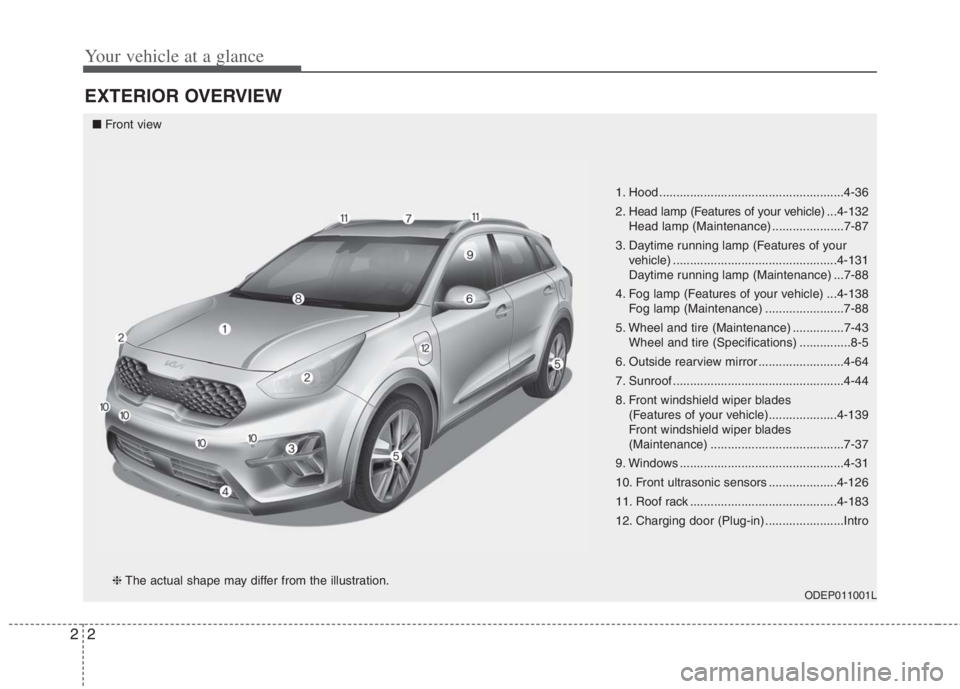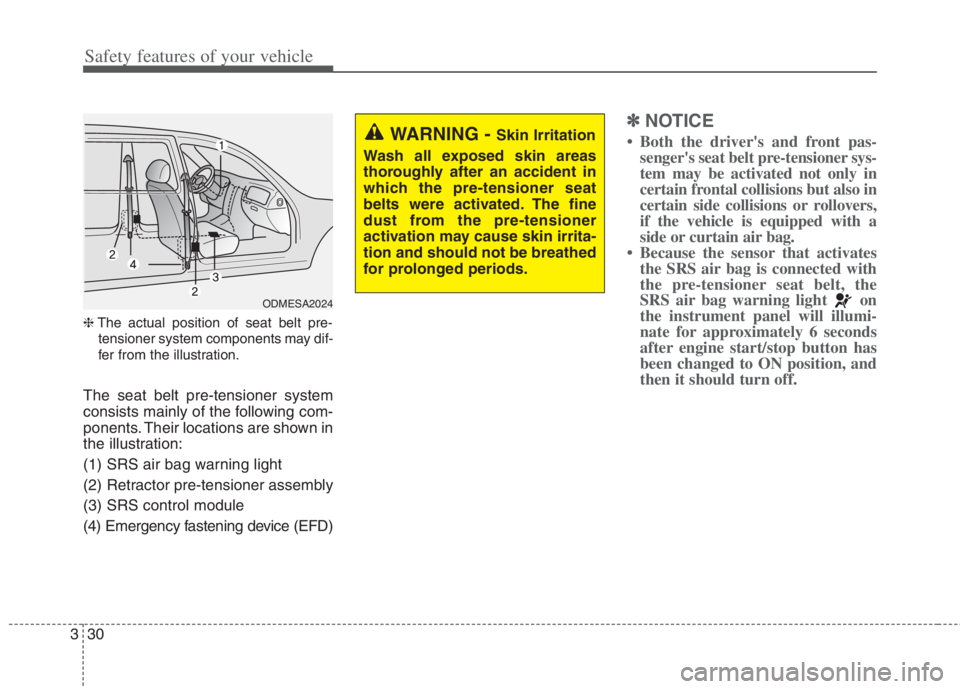Page 25 of 684
H22
CHARGING THE PLUG-IN HYBRID VEHICLE (CONT.)
Control BoxIndicatorDetails
PLUG
On : Power on
Blink : Plug temperature sensor failure
On : Plug high temperature protection
Blink : Plug high temperature warning
POWEROn : Power on
CHARGEBlink : Charging In power saving mode, only the CHARGE
indicator is illuminated.
FAU LTBlink : Charging interrupted
CHARGE
LEVEL
Charging
current 12 AThe charging current changes (3
level) whenever the button (1) is
pressed for 1 sec with the charg-
er plugged into an electrical out-
let but not the vehicle.
Charging
current 10 A
Charging
current 8 A
VEHICLE
Charging connector plugged
Charging
Blink : Not charging
Charging Status Indicator Lamp for Portable Charging Cable
(Green)
(Red)
(Green)
(Blue)
(Red)
Page 26 of 684
H23
Charging Status Indicator Lamp for Portable Charging Cable
NOControl BoxStatus / Diagnosis / CountermeasureNOControl BoxStatus / Diagnosis / Countermeasure
1
Have your vehicle inspected by an authorized
Kia dealer if any of the following occur:
Charging connector plugged into vehicle
(Green ON)
Plug temperature sensor failure
(Green blink)
Plug high temperature protection
(Red blink)
Plug high temperature warning (Red ON)
2- Charging connector plugged into the
vehicle (Green ON)
3
- While charging
4
Have your vehicle inspected by an
authorized Kia dealer if any of the fol-
lowing occur:
- Before plugging charging connector
into the vehicle (Red blink)
Page 27 of 684
H24
CHARGING THE PLUG-IN HYBRID VEHICLE (CONT.)
NOControl BoxStatus / Diagnosis / CountermeasureNOControl BoxStatus / Diagnosis / Countermeasure
5
Have your vehicle inspected by an authorized
Kia dealer if any of the following occur:
- Plugged into the vehicle (Red blink)
6
- After plugging charging connector
into vehicle (Red blink)
Have your vehicle inspected by an
authorized Kia dealer.
7
Have your vehicle inspected by an authorized
Kia dealer if any of the following occur:
Plug temperature sensor failure
(Green blink)
Plug high temperature protection
(Red blink)
Plug high temperature warning (Red ON)
8
- Power saving mode
(Green blink)
Page 61 of 684

Your vehicle at a glance
2 2
EXTERIOR OVERVIEW
1. Hood ......................................................4-36
2. Head lamp (Features of your vehicle) ...4-132
Head lamp (Maintenance) .....................7-87
3. Daytime running lamp (Features of your
vehicle) ................................................4-131
Daytime running lamp (Maintenance) ...7-88
4. Fog lamp (Features of your vehicle) ...4-138
Fog lamp (Maintenance) .......................7-88
5. Wheel and tire (Maintenance) ...............7-43
Wheel and tire (Specifications) ...............8-5
6. Outside rearview mirror .........................4-64
7. Sunroof ..................................................4-44
8. Front windshield wiper blades
(Features of your vehicle)....................4-139
Front windshield wiper blades
(Maintenance) .......................................7-37
9. Windows ................................................4-31
10. Front ultrasonic sensors ....................4-126
11. Roof rack ...........................................4-183
12. Charging door (Plug-in) .......................Intro
ODEP011001L
■Front view
❈The actual shape may differ from the illustration.
Page 62 of 684
23
Your vehicle at a glance
1. Door locks .............................................4-22
2. Fuel filler door ..............................4-38, 4-40
3. Rear combination lamp
(Maintenance) .......................................7-89
4. High mounted stop lamp
(Maintenance) .......................................7-89
5. Liftgate...................................................4-28
6. Antenna ...............................................4-184
7. Rear wiper and Rear view
camera (Features of your
vehicle) .....................................4-139, 4-122
Rear window wiper blade (Maintenance) ...7-39
8. Rear ultrasonic sensors ...........4-123, 4-126
ODEP011002N
■Rear view
❈The actual shape may differ from the illustration.
Page 95 of 684

Safety features of your vehicle
30 3
❈The actual position of seat belt pre-
tensioner system components may dif-
fer from the illustration.
The seat belt pre-tensioner system
consists mainly of the following com-
ponents. Their locations are shown in
the illustration:
(1) SRS air bag warning light
(2) Retractor pre-tensioner assembly
(3) SRS control module
(4) Emergency fastening device (EFD)
✽ ✽
NOTICE
• Both the driver's and front pas-
senger's seat belt pre-tensioner sys-
tem may be activated not only in
certain frontal collisions but also in
certain side collisions or rollovers,
if the vehicle is equipped with a
side or curtain air bag.
• Because the sensor that activates
the SRS air bag is connected with
the pre-tensioner seat belt, the
SRS air bag warning light on
the instrument panel will illumi-
nate for approximately 6 seconds
after engine start/stop button has
been changed to ON position, and
then it should turn off.WARNING - Skin Irritation
Wash all exposed skin areas
thoroughly after an accident in
which the pre-tensioner seat
belts were activated. The fine
dust from the pre-tensioner
activation may cause skin irrita-
tion and should not be breathed
for prolonged periods.
ODMESA2024
Page 113 of 684

Safety features of your vehicle
48 3
How does the air bag system
operate?
Air bags are activated (able to
inflate if necessary) only when the
ignition switch is turned to the ON
or START position or when engine
start/stop button has been
changed to ON position.
The appropriate air bags inflate
instantly in the event of a serious
frontal collision or side collision in
order to help protect the occupants
from serious physical injury.
There is no single speed at which
the air bags will inflate.
Generally, air bags are designed to
inflate based upon the severity of a
collision and its direction. These
two factors determine whether the
sensors produce an electronic
deployment/ inflation signal.
Air bag deployment depends on a
number of factors including vehicle
speed, angles of impact, and, the
density and stiffness of the vehi-
cles or objects which your vehicle
hits in the collision. The determin-
ing factors are not limited to those
mentioned above. The front air bags will completely
inflate and deflate in an instant.
It is virtually impossible for you to
see the air bags inflate during an
accident.
It is much more likely that you will
simply see the deflated air bags
hanging out of their storage com-
partments after the collision.
In addition to inflating in serious
side collisions, side and/or curtain
air bags will inflate if the sensing
system detects a rollover.
When a rollover is detected, side
and/or curtain air bags will remain
inflated longer to help provide pro-
tection from ejection, especially
when used in conjunction with the
seat belts. In order to help provide protection,
the air bags must inflate rapidly.
The speed of the air bag inflation is
a consequence of extremely short
time in which to inflate the air bag
between the occupant and the
vehicle structures before the occu-
pant impacts those structures. This
speed of inflation reduces the risk
of serious or life-threatening
injuries and is thus a necessary
part of the air bag design.
However, air bag inflation can also
cause injuries which can include
facial abrasions, bruises and bro-
ken bones because the inflation
speed also causes the air bags to
expand with a great deal of force.
There are even circumstances
under which contact with the
steering wheel or passenger air
bag can cause fatal injuries,
especially if the occupant is
positioned excessively close to
the steering wheel or passenger
air bag.
Page 116 of 684
351
Safety features of your vehicle
SRS components and functions
❈The actual position of SRS compo-
nents may differ from the illustration.
The SRS consists of the following
components:
1. Driver's front air bag module
2. Passenger's front air bag module
3. Side air bag modules
4. Curtain air bag modules
5. Driver’s knee air bag module
6. Retractor pre-tensioner assemblies
7. Air bag warning light8. SRS control module (SRSCM)
9. Front impact sensors
10. Side impact sensors
11. Side pressure sensors
12. Occupant detection system
(Front passenger’s seat only)
13. Front passenger’s seat belt
buckle sensor
14. Retractor pre-tensioner assem-
blies*
*: if equippedIf the air bag warning light is illumi-
nated for more than 6 seconds after
engine start/stop button has been
changed to ON, or if it illuminates
during vehicle operation, an SRS
component may not be functioning
properly and you should have your
vehicle checked by an authorized Kia
dealer.
W7-147
ODEP031114N